Speech The State of the Mortgage Market
Thank you for the opportunity to address this forum. Today, I intend to talk about the past, present and future of the mortgage market in Australia. It is useful to recount some of the history of the mortgage market to put the current state of the market in to better context and provide a basis for thinking about how the market might evolve in the period ahead.
History
In the 1960s and early 1970s, the Australian financial system was heavily regulated.[2] There was a number of wide-ranging controls including:
- The interest rates that banks could charge on their loans and pay on their deposits were controlled.
- Banks were subject to reserve ratios and liquidity ratios.
- There were directives on the overall quantity of loans banks should make, as well as moral suasion on who they should lend to.
- Institutions were specialised – trading banks lent to businesses, savings banks held large quantities of Government debt and lent to households (almost entirely for housing), and finance companies lent for more risky property loans and consumer credit.
These regulatory controls on the banks reduced their capacity to adjust to changing conditions and imposed a cost disadvantage on them. As a result they lost market share to the unregulated financial sector, primarily building societies. The banks' share of total financial intermediary assets declined from nearly 90 per cent in the early 1950s to 70 per cent in 1970. The banks' share of housing credit was just below 60 per cent in 1976 with much of the rest of the mortgage market being provided by credit unions and building societies. Finance companies, which were generally associated with the banks, often provided top-up funding to bank mortgages but were not a particularly large share of the overall market.
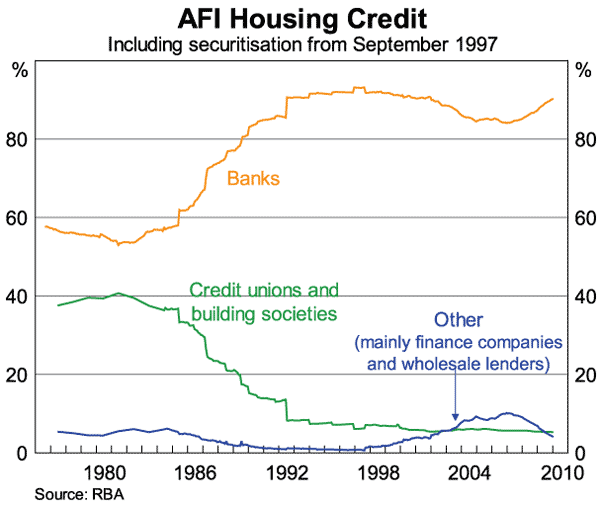
Financial deregulation in Australia began slowly in the 1970s, before accelerating sharply in the early 1980s. It affected the quantity of credit provided, the pricing and the structure of the mortgage market (Graph 1).
The main developments were the reduction of the prescribed assets ratio which was the minimum share of total assets that savings banks were required to invest in Government debt. As this was gradually reduced from 70 per cent to 40 per cent between 1963 and 1978, savings banks could correspondingly increase the share of housing lending in their assets.
On the pricing front, the interest rate ceiling on large housing loans was removed in the early 1970s and then in April 1986, the interest rate ceiling on all new housing loans, 13½ per cent at the time, was removed. (Existing loans remained subject to the 13½ per cent cap until they were discharged.)
In terms of the structure of the market, the distinction between savings banks and trading banks was removed in 1989. Prior to that, in the mid 1980s, 15 foreign banks were given licences to operate in the Australian market. However, the foreign banks, in the main, focussed on lending to businesses rather than lending to households, in large part because they did not have a branch network which would enable them to compete effectively against the local banks. Further financial innovation which would have facilitated their ability to compete without a branch network was still nearly a decade away.
The major change in market structure was that a number of building societies and credit unions converted to banks through the 1980s and early 1990s. Becoming a bank allowed these institutions a greater capacity to expand their capital base.
More generally, in the first few years after deregulation, business lending grew much more quickly than housing lending. Between January 1985 and December 1988 business lending grew at an average annual pace of 30 per cent, while housing lending grew by 22 per cent.[3] As a result, the share of business loans in banks' total lending rose from 54 per cent to 62 per cent over this period.
However, in the early 1990s, a number of factors contributed to the banking system shifting its focus from lending to business towards housing:
- First, the banks suffered large losses on their business loan portfolios during the early 1990s recession. In contrast, the losses on their housing loans were relatively mild, notwithstanding the fact that the unemployment rate rose to about 11 per cent and mortgage rates reached as high as 17 per cent.
- Second, demand for credit from the corporate sector declined as the sector underwent a period of deleveraging.
- Third, the introduction of the (first) Basel Capital Accord saw a change in the risk weighting in favour of housing assets. In August 1988, the Reserve Bank of Australia (which was then the banking sector regulator) issued guidelines for a risk-based measurement of banks' capital adequacy, broadly consistent with the Basel proposals. Prior to this, Australia used a capital-to-total assets ratio for measuring the capital adequacy of banks, which gave banks an incentive to invest in riskier, but higher yielding assets.[4] Under the new risk-based approach, housing loans were given a risk weight of 50 per cent, whereas business and personal loans had a risk weight of 100 per cent. Banks were required to satisfy the new capital adequacy requirements by 1992, but as early as 1990 they had taken steps to increase their capital bases to the required levels.
As a result of these factors, between 1991 and 1995 the share of business loans in banks' total lending fell by 15 percentage points to 48 per cent, while the share of housing lending rose by 16 percentage points to 46 per cent. Since then, this trend has continued, reinforced by the continuing strong performance of housing loans and, in terms of demand for credit, the shift downwards in the nominal interest rate structure as the low inflation environment was achieved and maintained. Currently, the share of housing loans in banks' total lending stands at 58 per cent, while the share of business lending is about 35 per cent.
Rise of the Wholesale Lenders
The next development which had a material effect on the structure and pricing of the mortgage market was the rise of the wholesale lenders.
As nominal interest rates came down in the early 1990s, mortgage rates declined more slowly such that the spreads on banks' housing loans increased. In 1993, the spread between the variable mortgage rate and the cash rate was about 430 basis points (Graph 2). The reduction in inflation and nominal interest rates eroded the banks' funding advantage obtained from interest-free deposits. These factors, together with the lower level of money market rates (and their increased stability), provided the opportunity for wholesale lenders to enter the market. These new institutions competed aggressively for market share by undercutting banks' mortgage rates and by introducing new mortgage products such as home equity loans, interest only loans and low documentation loans (see below). The wholesale lenders' share of housing loan approvals rose quickly from 2 per cent in 1993 to 8 per cent in 1996 (Graph 3). The banks responded to this increased competition by reducing their spreads, such that by 1997, the spread over the cash rate on their indicator housing rates had decreased to about 175 basis points.
The ability of the wholesale lenders to compete effectively was considerably enhanced by the growth of the residential mortgage backed securities (RMBS) market. This provided a source of funds to these lenders which did not have the deposit base of the financial institutions. These lenders had no balance sheet, little capital and no branch structure and hence were low cost operations with a large degree of flexibility.
In subsequent years, the regional banks, along with credit unions and building societies, also made significant use of securitisation as a relatively cheap source of funding. The major banks also issued RMBS to diversify their funding base but it was never a large part of their funding.
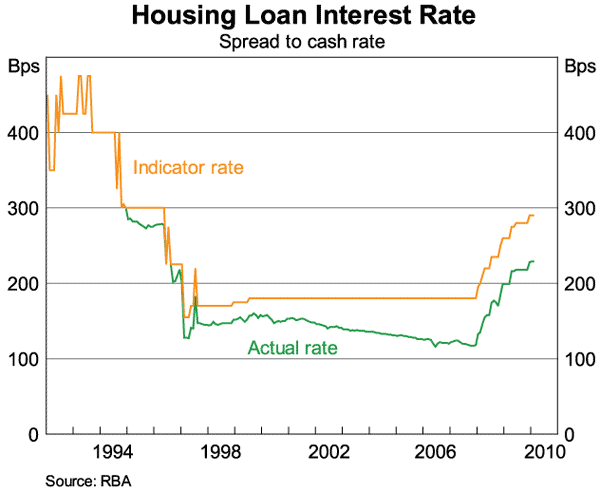
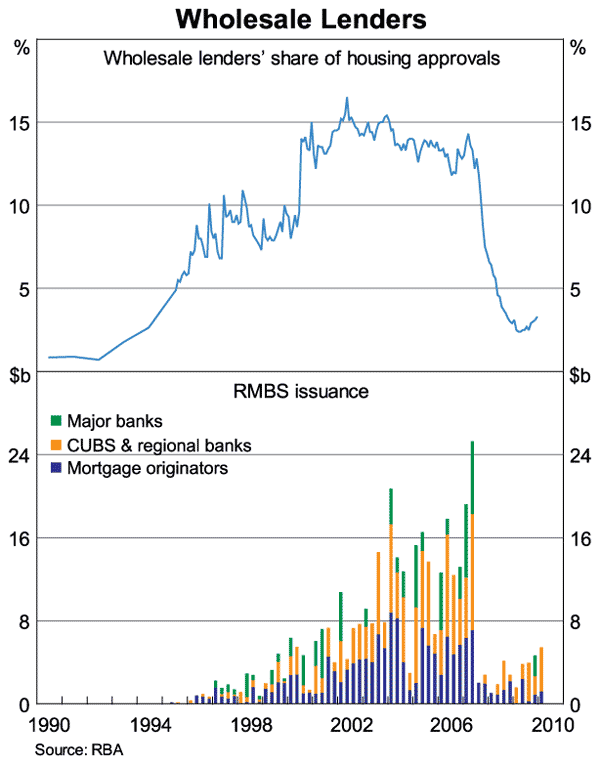
In a further response to the competition from the wholesale lenders, in the early 2000s, banks began increasing the discount offered on the standard mortgage rate to new borrowers. This enabled banks to slow the repricing of their loan books because only new or refinancing borrowers benefited from the discounts, whereas changes to their standard variable rate immediately flowed through to all borrowers. Initially banks did not publicise these discounts, but since the mid 2000s, they have been quite open about them, and now the vast majority of new borrowers pay an interest rate that is below the standard variable rate. The discount has grown over time and has spread to most borrowers. Currently the average borrower is receiving a discount of around 60 basis points on the standard variable rate. This discounting saw the spread between the cash rate and the actual mortgage rate paid narrow further over the decade to 2007.
As I mentioned earlier, the foreign banks focussed primarily on the corporate market when they first began business in the mid 1980s, but from the beginning of this decade, they have increased their focus on retail banking, including housing lending. Their share of housing loan approvals increased from about 1 per cent in 2000 to a peak of about 15 per cent in 2008 (Graph 4). Two related factors have contributed to the foreign banks' increased market share. First, starting off with a small portfolio of mortgages meant that the foreign-owned banks were able to advertise lower interest rates without adversely affecting the profitability of a large stock of loans to existing customers. Second, the wider acceptance on the part of customers of applying for loans over the internet and the use of the broker network has increased the ability of these banks to reach new borrowers without establishing a costly branch network.[5] During late 2008 and 2009 however, the foreign banks' market share fell significantly, in large part because of the reduction in lending by Bank-West.
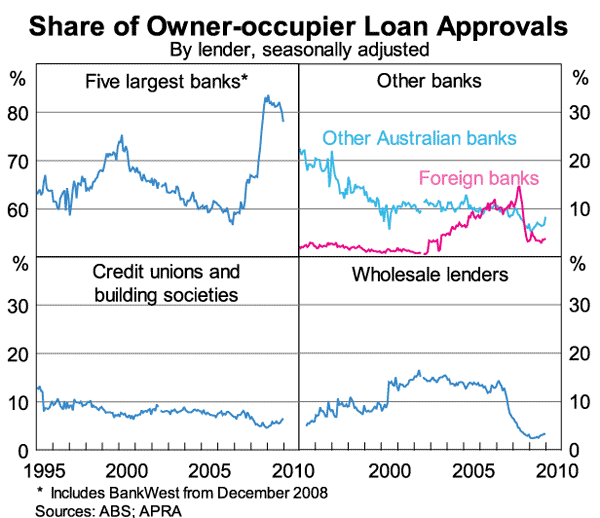
More generally, the emergence of mortgage brokers, who act as intermediaries between lenders and borrowers and make it easier for borrowers to compare the costs and features of different loans, has contributed to the increase in competition between lenders in the Australian mortgage market. Mortgage brokers' share of total mortgage settlements is about one-third of all loans.
Product Innovation
Through the late 1990s and first half of the 2000s, there was considerable product innovation in the Australian mortgage market. Lenders sought to cater for a wider range of potential borrowers and found new ways to assess their borrowing capacity. Some of this innovation has resulted in an easing in lending standards and an increase in risk for both borrowers and lenders, but its overwhelming effect has been to widen the range of households who can access finance.[6] Moreover, when the lending was more risky, lenders charged a larger spread on these loans to take account of the greater risk and required lower loan to valuation ratios (LVRs) for these loans.
Lenders introduced home-equity loans, redraw facilities and reverse mortgages, all of which allowed households to borrow against the equity they have built up in their homes. Lenders also introduced interest-only loans and shared-equity loans, which made it easier for households, particularly first home buyers, to purchase their home.
Loan products that better meet the needs of certain types of borrowers, such as those with irregular income streams or those who do not meet the standard lending criteria, were also introduced. Low-doc loans, for which borrowers self-certify their income in the application process, accounted for about 10 per cent of newly approved housing loans in 2006, compared with less than ½ per cent in 2000 (Table 1).
There was also an increase in non-conforming loans for borrowers who do not meet the standard lending criteria of mainstream lenders. These borrowers typically have poor credit or payment histories. In 2006, non-conforming loans comprised 2 per cent of new loan approvals, compared with less than ½ per cent in 2000.
| Per cent of approvals
|
Per cent of outstandings |
|||||
|---|---|---|---|---|---|---|
| 2000 | 2002 | 2004 | 2006 | 2009 | 2009 | |
| Prime loans | ||||||
| Full-doc | >99 | 96 | 88½ | 88 | 92 | 92 |
| Low-doc | <½ | 3 | 10 | 10 | 8 | 7 |
| Non-conforming loans | <½ | 1 | 1½ | 2 | 0 | <1 |
Sources: ABS; Banks' annual reports; RBA; Standard and Poor's |
||||||
Lending Standards and Arrears
Fortunately, lending standards in Australia did not loosen as much as in some offshore markets. There was very little sub-prime lending of the form more common in the United States for example, where loans were provided to those with poor credit histories. The non-conforming loan market, which was the closest equivalent in Australia, never reached more than 2 per cent of new loans, and is currently less than 1 per cent of loans outstanding. Only a few fringe institutions were involved in the market. There are almost no non-conforming loans being issued at the moment, with the providers of such loans having exited or gone into extended hibernation.
Consistent with this, and the stronger underlying economic conditions in Australia, the share of non-performing housing loans in Australia has remained very low (Graph 5). In December 2009, the share was 0.6 per cent in Australia, much the same as it was 15 years ago. Compared with other countries, this is only a little above the 0.4 per cent in Canada and well below the 2½–3 per cent in the UK and Spain and 8 per cent in the US.
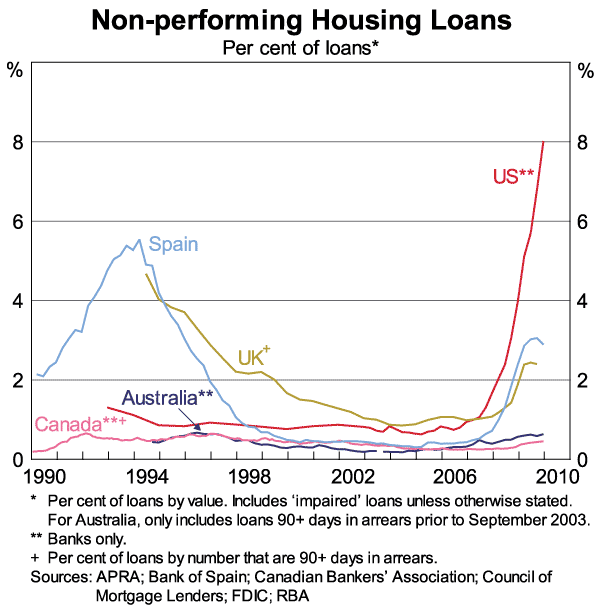
Looking at the Australian data in more detail, the proportion of banks' on-balance sheet housing loans that were in arrears or impaired in December 2009 was 0.6 per cent. This is up from the very low levels in 2002–2003, but still low in absolute terms. The arrears rate has tended to be relatively stable in recent months.
Australian residential mortgage backed securities have continued to perform very well. This is reflected in data from a lenders' mortgage insurance provider and the RMBS market, which show that annual losses on insured prime housing loans averaged 4 basis points between 1980 and 2010, with the highest loss in any one year being 10 basis points.[7] As a result, even the holders of lower rated tranches of RMBS have not suffered any losses, as the insurance, together with the subordination embodied in the RMBS, has provided a more than adequate buffer.
The Effect of the Financial Crisis
The financial crisis has had a material affect on pricing and structure in the Australian mortgage market but has not had a particularly marked impact on the quantity of housing credit provided.
Beginning around the middle of 2007, there was a widespread reappraisal of the risks associated with investing in structured credit products. Securitisation started to suffer severe brand damage as primarily US RMBS incurred significant credit problems as delinquency rates began to rise.[8] Initially, the problems were most evident in the sub-prime mortgage market, but they later spread to prime mortgages in the US as well. Combined with the decline in house prices, these delinquency rates have led to large losses for investors in US RMBS.
The Australian RMBS market was significantly affected, even though (as already discussed) lending standards were much better in Australia, and the RMBS continued to perform well. Issuance dried up markedly (Graph 6). Most of the issuance during late 2008 and the first half of 2009 was purchased by the Australian Government through the Australian Office of Financial Management. Offshore SIVs, which had been large buyers of Australian RMBS prior to the financial crisis, were forced to liquidate their portfolios as they were no longer able to fund themselves. These sales into the secondary market drove spreads from about 15 basis points (over the bank bill swap rate) pre-crisis to a peak of over 400 basis points in early 2009. This very wide secondary market spreads also deterred new issuance.
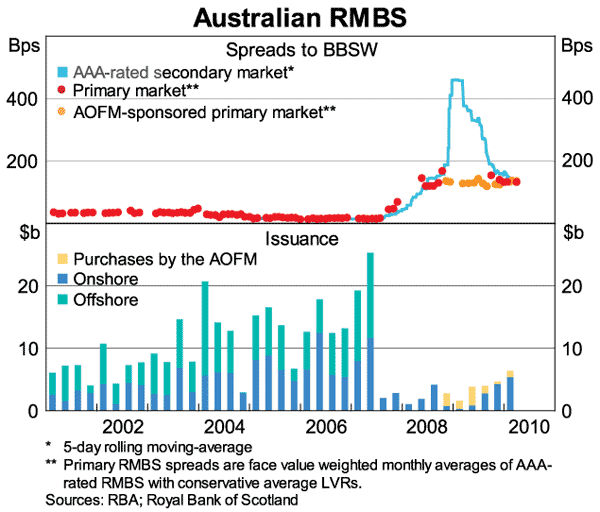
The crisis also had a material effect on the funding costs of all providers in the mortgage market. In addition to the effect on RMBS funding described above, wholesale (and particularly recently) retail funding costs have risen relative to the cash rate.[9]
In response to the rise in funding costs, all institutions have raised their mortgage rates relative to the cash rate. Interestingly, while the standard variable rate has been increased, there is little sign of any reduction in the discounts offered on new loans. The average rate on variable rate housing loans has increased by around 110 basis points relative to the cash rate since mid 2007 (Graph 7).[10] This increase, relative to the cash rate, is below the estimated 130 to 140 basis point rise in banks' overall funding costs over this period. In contrast, banks' business and personal loans have increased by even more relative to the cash rate and by more than the rise in funding costs.
Because the funding costs of the smaller participants have tended to rise by more, their profit margins have been squeezed more and in some cases, their capacity to provide new loans has also been curtailed. Some participants have been able to remain competitive and profitable only by cross-subsidising their new issuance using the large spread they are earning on their back book of mortgages. These mortgages were funded pre-crisis, so that the subsequent upward repricing of the whole mortgage book has resulted in the older loans now earning a wide margin.
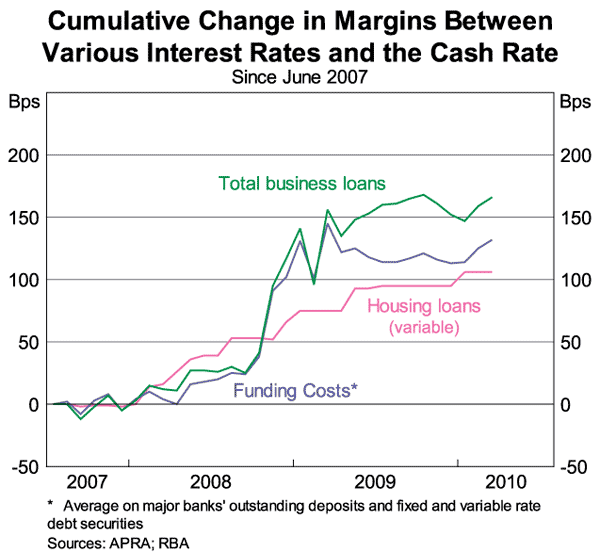
The pressure on funding during the crisis, together with the near closure of the RMBS market, changed the competitive dynamics in the mortgage market. The market share of wholesale lenders (who relied almost exclusively on securitisation) fell from about 13 per cent in mid 2007 to about 2 per cent by early 2009. Several of the larger wholesale lenders were acquired by the major banks (CBA bought into Aussie and Aussie bought Wizard; Westpac bought RAMS distribution business; NAB bought Challenger's mortgage business). The share of housing loan approvals by smaller banks, credit unions and building societies also declined, though not as sharply. The major banks' combined market share rose from 60 per cent to over 80 per cent over this period.
Nevertheless, housing finance has been readily available throughout the crisis period, with housing credit growing at about 8 per cent a year. The larger banks have filled the gap left by the decline of the wholesale lenders, so that there has not been a material constraint on the quantity of housing credit available in Australia throughout the crisis.
There has, however, been some tightening in lending standards, with several banks reducing their maximum LVRs on prime, full-doc loans for new borrowers from 95–97 per cent to about 90 per cent during 2009. Banks have also raised their interest rate buffers and increased their ‘genuine savings’ requirements. Low-doc and non-conforming loans have become much harder to obtain. This has seen a decline in the share of new owner-occupier housing loans with a LVR above 90 per cent, from a peak of 27 per cent in the March quarter 2009 to 17 per cent by the end of the year. The share of low-doc loans has declined to about 7 per cent.
There has been a decrease in the shares of new investor loans that are being written with higher loan-to-valuation ratios (LVRs) or lower documentation standards. There has also been a decline in the share of interest-only loans, though it is still the case that close to half of all new investor housing borrowers are opting to not make any principal repayments, reflecting the tax advantages of this funding strategy.
The Future
Looking forward, the competitive state of the current market is reflected in the fact that home lending rates have not risen by as much as funding costs. Moreover, the outlook for the smaller lenders has improved since mid 2009. The securitisation market is starting to recover, with the volume of issuance to non-AOFM investors picking up and secondary market spreads decreasing.
Securitisation is once again becoming a more viable funding source for lenders, with spreads on newly issued RMBS – around 130 to 135 basis points over one-month bank bills for non-AOFM supported deals – a little below our estimated break-even spread of around 160 basis points. However, our estimate of the break-even spread, and hence the profitability of the issue, does not take into account different degrees of subordination across issues. To the extent that that the degree of subordination required by investors is greater than it was previously, the overall profitability of the issue will be lower. This is because a greater share of the security is retained on the book of the issuer, or sold at a higher cost to another investor, reducing the return from the deal. (However, this effect on overall profitability is much smaller than the increase in spreads since the crisis.)
The cost of long-term and short-term wholesale funding has also decreased since mid 2009, though the cost of deposits remains high. Consistent with this, the smaller lenders' market shares have risen slightly over recent months, though they are unlikely to return to pre-crisis levels any time soon. The pre-crisis level of RMBS activity, which these institutions relied more heavily on, was supported by demand from offshore SIVs which is no longer there. But as the major banks have increased their lending rates to recoup increased funding costs, and as funding costs for securitisation have fallen, the smaller participants have become increasingly more competitive.
While interest rates on mortgages have increased relative to the cash rate, the Reserve Bank is able to take account of those changes in its policy deliberations. The cash rate determined by the Reserve Bank is still the major determinant of the interest rate structure in Australia, including that of mortgage rates.
With the securitisation market showing greater vitality in recent months, the housing loan market remains contestable. Any widening in margins is likely to attract new competitors into the market. Already, the improvement in securitisation has encouraged some of the smaller lenders back into the market and encouraged some brokers to again look to increase their own mortgage lending.
With these developments, the provision of mortgage credit in Australia is likely to continue to be adequate in a competitive marketplace.
Endnotes
I thank Michael Davies, Dan Fabbro, Megan Garner and Jennifer Pitman for their help in preparing this talk. [1]
This draws on Battellino R (2007), ‘Australia's Experience with Financial Deregulation’, Address to China Australia Governance Program, 16 July, Melbourne. [2]
These are nominal growth rates. Inflation during this period averaged 8 per cent. [3]
See: Lewis MK and RH Wallace (eds) (1997), The Australian Financial System: Evolution, Policy and Practice, Addison Wesley Longman, Melbourne; RBA (1988), ‘Supervision of Capital Adequacy of Banks’, Bulletin, February, pp 14–26; RBA (1998), ‘Capital Adequacy of Banks’, Bulletin, September, pp 11–16. [4]
See RBA (2007), ‘Box C: ‘Foreign-Owned Banks in Australia’, Financial Stability Review, March, pp 47–49. [5]
See APRA (Australian Prudential Regulation Authority) and RBA (2007), ‘Joint RBA-APRA submission to
the Inquiry into Home Lending Practices and
Processes’, August, and RBA (2008),
‘RBA Submission
to the Inquiry into Competition in the Banking
and Non-Banking Sectors’, 10 July. [6]
RBA (2006), ‘The Performance of Australian Residential Mortgage-Backed Securities’, Financial Stability Review, March, pp 63–68. [7]
See Debelle G (2009), ‘Whither Securitisation?’, speech given to the Australian Securitisation Conference 2009, Sydney 18 November. [8]
See Brown A, M Davies, D Fabbro and T Hanrick (2010), ‘Recent Developments in Banks' Funding Costs and Lending Rates’, RBA Bulletin, March Quarter, pp 35–44. [9]
The average rates on all outstanding housing loans has increased by around 145 basis points over this period, as rates on the major banks' new 3- and 5-year fixed-rate housing loans have risen by 170–180 basis points relative to equivalent maturity swap rates (and by more relative to the cash rate because of the current slope of the yield curve). [10]
